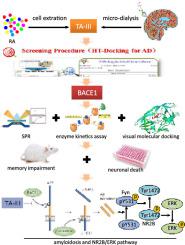Phytomedicine ( IF 6.7 ) Pub Date : 2020-05-24 , DOI: 10.1016/j.phymed.2020.153244 Hai-Qiao Wang 1 , Min Liu 2 , Liang Wang 3 , Fen Lan 2 , Yi-Han Zhang 2 , Jin-Er Xia 2 , Zhen-Dong Xu 3 , Hai Zhang 3

|
Background
Rhizoma Anemarrhenae (RA) has been conventionally used for treatment of Alzheimer's disease (AD) in Traditional Chinese Medicine, and thus, the active components from RA can be screened.
Purpose
This research aimed to identify the active components of RA and their targets and further clarify the molecular mechanisms underlying its anti-AD activity.
Methods
First, the potential active compounds from RA were screened by neurocyte extraction and micro-dialysis methods. Second, the potential targets were predicted by a chemogenomics target knowledgebase and further explored by surface plasmon resonance and enzyme activity assays. Third, the pharmacological effects were evaluated by employing APP/PS1 transgenic mice and SH-SY5Y-APP cells. ELISAs and Western blot analyses were used to evaluate the expression of key molecules in the amyloidogenic and NMDAR/ERK pathways.
Results
Timosaponin A-III (TA-III) was screened and identified as a potential active component for the anti-AD activity, and BACE1 was proven to be a potential high-affinity target. Enzyme kinetic analysis showed that TA-III had strong noncompetitive inhibitory activity against BACE1. The in vitro and in vivo assays indicated that TA-III had pharmacological effects through improving memory impairment, reducing Aβ aggregation via the amyloidogenic pathway and preventing neuronal impairment through downregulating the NMDAR/ERK signaling pathway.
Conclusion
TA-III targets BACE1 to reduce Aβ aggregation through down-regulating the NMDAR/ERK pathway for treating AD.
中文翻译:

通过细胞提取和化学基因组学目标知识库指导方法鉴定新型 BACE1 抑制剂知莫皂苷 A-III,用于治疗阿尔茨海默病。
背景
知母(RA)在中药中常用于治疗阿尔茨海默病(AD),因此可以筛选RA的活性成分。
目的
本研究旨在鉴定RA的活性成分及其靶点,并进一步阐明其抗AD活性的分子机制。
方法
首先,通过神经细胞提取和微透析方法筛选RA中的潜在活性化合物。其次,通过化学基因组学目标知识库预测潜在目标,并通过表面等离子共振和酶活性测定进一步探索。第三,利用APP/PS1转基因小鼠和SH-SY5Y-APP细胞评价药理作用。使用 ELISA 和蛋白质印迹分析来评估淀粉样蛋白生成和 NMDAR/ERK 途径中关键分子的表达。
结果
知母皂苷 A-III (TA-III) 被筛选并鉴定为抗 AD 活性的潜在活性成分,BACE1 被证明是潜在的高亲和力靶点。酶动力学分析表明TA-III对BACE1具有很强的非竞争性抑制活性。体外和体内试验表明,TA-III 通过改善记忆障碍、通过淀粉样蛋白生成途径减少 Aβ 聚集以及通过下调 NMDAR/ERK 信号通路预防神经元损伤来发挥药理作用。
结论
TA-III 以 BACE1 为靶点,通过下调 NMDAR/ERK 通路来减少 Aβ 聚集,从而治疗 AD。































 京公网安备 11010802027423号
京公网安备 11010802027423号